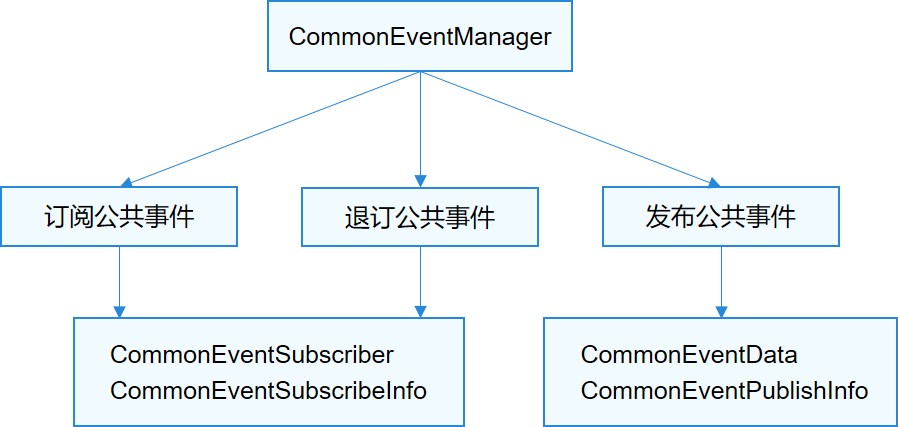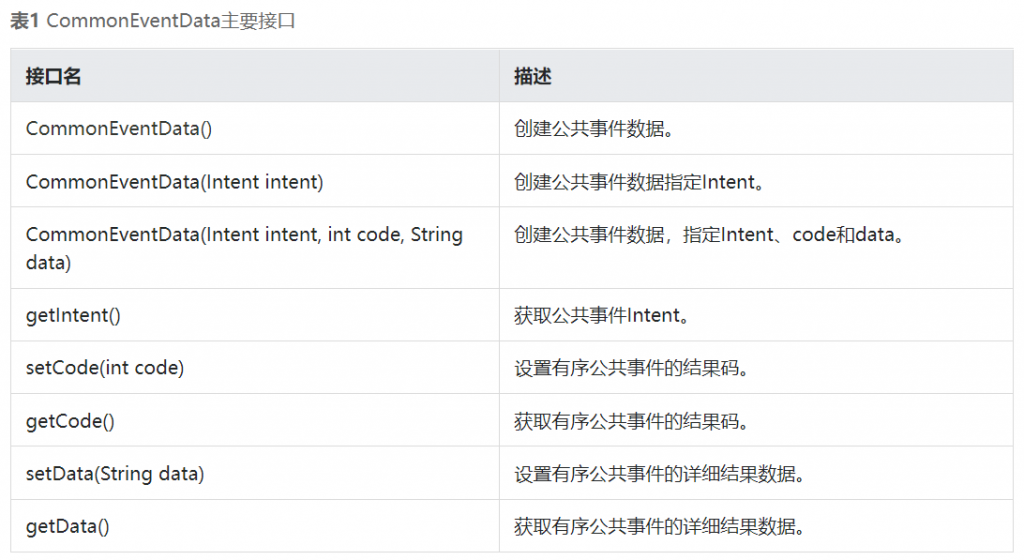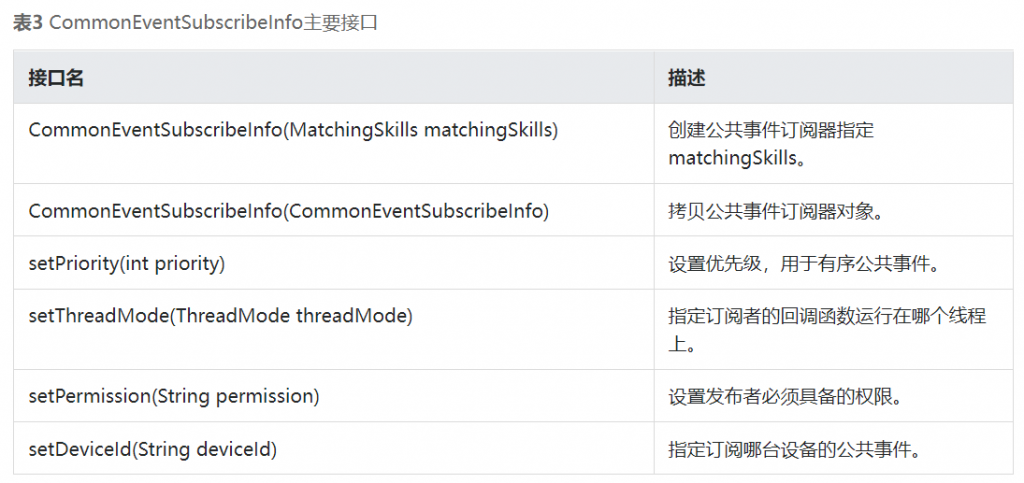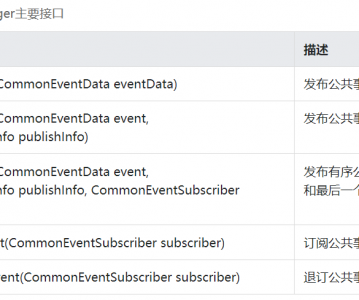场景介绍
每个应用都可以订阅自己感兴趣的公共事件,订阅成功后且公共事件发布后,系统会把其发送给应用。这些公共事件可能来自系统、其他应用和应用自身。HarmonyOS提供了一套完整的API,支持用户订阅、发布和接收公共事件。发布公共事件需要借助CommonEventData对象,接收公共事件需要继承CommonEventSubscriber类并实现onReceiveEvent回调函数。
接口说明
公共事件相关基础类包含CommonEventData、CommonEventPublishInfo、CommonEventSubscribeInfo、CommonEventSubscriber和CommonEventManager。基础类之间的关系如下图所示:
图1 公共事件基础类关系图

CommonEventDataCommonEventData封装公共事件相关信息。用于在发布、分发和接收时处理数据。在构造CommonEventData对象时,相关参数需要注意以下事项:
- code为有序公共事件的结果码,data为有序公共事件的结果数据,仅用于有序公共事件场景。
- intent不允许为空,否则发布公共事件失败。

CommonEventPublishInfoCommonEventPublishInfo封装公共事件发布相关属性、限制等信息,包括公共事件类型(有序或粘性)、接收者权限等。
- 有序公共事件:主要场景是多个订阅者有依赖关系或者对处理顺序有要求,例如:高优先级订阅者可修改公共事件内容或处理结果,包括终止公共事件处理;或者低优先级订阅者依赖高优先级的处理结果等。有序公共事件的订阅者可以通过CommonEventSubscribeInfo.setPriority()方法指定优先级,缺省为0,优先级范围[-1000, 1000],值越大优先级越高。
- 粘性公共事件:指公共事件的订阅动作是在公共事件发布之后进行,订阅者也能收到的公共事件类型。主要场景是由公共事件服务记录某些系统状态,如蓝牙、WLAN、充电等事件和状态。不使用粘性公共事件机制时,应用可以通过直接访问系统服务获取该状态;在状态变化时,系统服务、硬件需要提供类似observer等方式通知应用。发布粘性公共事件可以通过setSticky()方法设置, 发布粘性公共事件需要申请如下权限。声明请参考权限开发指导表1 reqPermissions权限申请字段说明。
"reqPermissions": [
{
"name": "ohos.permission.COMMONEVENT_STICKY",
"reason": "Obtain the required permission",
"usedScene": {
"ability": [
".MainAbility"
],
"when": "inuse"
}
},
{
...
}
]
CommonEventSubscribeInfo
CommonEventSubscribeInfo封装公共事件订阅相关信息,比如优先级、线程模式、事件范围等。线程模式(ThreadMode):设置订阅者的回调方法执行的线程模式。ThreadMode有HANDLER,POST,ASYNC,BACKGROUND四种模式,目前只支持HANDLER模式。
- HANDLER:在Ability的主线程上执行。
- POST:在事件分发线程执行。
- ASYNC:在一个新创建的异步线程执行。
- BACKGROUND:在后台线程执行。

CommonEventSubscriberCommonEventSubscriber封装公共事件订阅者及相关参数。
- CommonEventSubscriber.AsyncCommonEventResult类处理有序公共事件异步执行,详见API参考。
- 目前只能通过调用CommonEventManager的subscribeCommonEvent()进行订阅。

CommonEventManager
CommonEventManager是为应用提供订阅、退订和发布公共事件的静态接口类。

发布公共事件
开发者可以发布四种公共事件:无序的公共事件、带权限的公共事件、有序的公共事件、粘性的公共事件。发布无序的公共事件:构造CommonEventData对象,设置Intent,通过构造operation对象把需要发布的公共事件信息传入intent对象。然后调用 CommonEventManager.publishCommonEvent(CommonEventData) 接口发布公共事件。
try {
Intent intent = new Intent();
Operation operation = new Intent.OperationBuilder()
.withAction("com.my.test")
.build();
intent.setOperation(operation);
CommonEventData eventData = new CommonEventData(intent);
CommonEventManager.publishCommonEvent(eventData);
HiLog.info(LABEL_LOG, "Publish succeeded");
} catch (RemoteException e) {
HiLog.error(LABEL_LOG, "Exception occurred during publishCommonEvent invocation.");
}发布携带权限的公共事件:构造CommonEventPublishInfo对象,设置订阅者的权限。
"reqPermissions": [
{
"name": "com.example.MyApplication.permission",
"reason": "Obtain the required permission",
"usedScene": {
"ability": [
".MainAbility"
],
"when": "inuse"
}
},
{
...
}
]发布带权限的公共事件示例代码如下:
Intent intent = new Intent();
Operation operation = new Intent.OperationBuilder()
.withAction("com.my.test")
.build();
intent.setOperation(operation);
CommonEventData eventData = new CommonEventData(intent);
CommonEventPublishInfo publishInfo = new CommonEventPublishInfo();
String[] permissions = {"com.example.MyApplication.permission"};
publishInfo.setSubscriberPermissions(permissions); // 设置权限
try {
CommonEventManager.publishCommonEvent(eventData, publishInfo);
HiLog.info(LABEL_LOG, "Publish succeeded");
} catch (RemoteException e) {
HiLog.error(LABEL_LOG, "Exception occurred during publishCommonEvent invocation.");
}发布有序的公共事件:构造CommonEventPublishInfo对象,通过setOrdered(true)指定公共事件属性为有序公共事件,也可以指定一个最后的公共事件接收者。
CommonEventSubscriber resultSubscriber = new MyCommonEventSubscriber();
CommonEventPublishInfo publishInfo = new CommonEventPublishInfo();
publishInfo.setOrdered(true); // 设置属性为有序公共事件
try {
CommonEventManager.publishCommonEvent(eventData, publishInfo, resultSubscriber); // 指定resultSubscriber为有序公共事件最后一个接收者。
} catch (RemoteException e) {
HiLog.error(LABEL_LOG, "Exception occurred during publishCommonEvent invocation.");
}发布粘性公共事件:构造CommonEventPublishInfo对象,通过setSticky(true)指定公共事件属性为粘性公共事件。
- 发布者首先在config.json中申请发布粘性公共事件所需的权限,各字段含义详见权限申请字段说明。
{
"reqPermissions": [{
"name": "ohos.permission.COMMONEVENT_STICKY",
"reason": "Obtain the required permission",
"usedScene": {
"ability": [
".MainAbility"
],
"when": "inuse"
}
}, {
...
}]
}发布粘性公共事件。
CommonEventPublishInfo publishInfo = new CommonEventPublishInfo();
publishInfo.setSticky(true); // 设置属性为粘性公共事件
try {
CommonEventManager.publishCommonEvent(eventData, publishInfo);
} catch (RemoteException e) {
HiLog.error(LABEL, "Exception occurred during publishCommonEvent invocation.");
}订阅公共事件
- 创建CommonEventSubscriber派生类,在onReceiveEvent()回调函数中处理公共事件。
说明
此处不能执行耗时操作,否则会阻塞UI线程,产生用户点击没有反应等异常。
class MyCommonEventSubscriber extends CommonEventSubscriber {
MyCommonEventSubscriber(CommonEventSubscribeInfo info) {
super(info);
}
@Override
public void onReceiveEvent(CommonEventData commonEventData) {
}
}构造MyCommonEventSubscriber对象,调用CommonEventManager.subscribeCommonEvent()接口进行订阅。
String event = "com.my.test";
MatchingSkills matchingSkills = new MatchingSkills();
matchingSkills.addEvent(event); // 自定义事件
matchingSkills.addEvent(CommonEventSupport.COMMON_EVENT_SCREEN_ON); // 亮屏事件
CommonEventSubscribeInfo subscribeInfo = new CommonEventSubscribeInfo(matchingSkills);
MyCommonEventSubscriber subscriber = new MyCommonEventSubscriber(subscribeInfo);
try {
CommonEventManager.subscribeCommonEvent(subscriber);
} catch (RemoteException e) {
HiLog.error(LABEL, "Exception occurred during subscribeCommonEvent invocation.");
}如果订阅拥有指定权限应用发布的公共事件,发布者需要在config.json中申请权限,各字段含义详见权限申请字段说明。
"reqPermissions": [
{
"name": "ohos.abilitydemo.permission.PROVIDER",
"reason": "Obtain the required permission",
"usedScene": {
"ability": ["com.hmi.ivi.systemsetting.MainAbility"],
"when": "inuse"
}
}
]如果订阅的公共事件是有序的,可以调用setPriority()指定优先级。
String event = "com.my.test";
MatchingSkills matchingSkills = new MatchingSkills();
matchingSkills.addEvent(event); // 自定义事件
CommonEventSubscribeInfo subscribeInfo = new CommonEventSubscribeInfo(matchingSkills);
subscribeInfo.setPriority(100); // 设置优先级,优先级取值范围[-1000,1000],值默认为0。
MyCommonEventSubscriber subscriber = new MyCommonEventSubscriber(subscribeInfo);
try {
CommonEventManager.subscribeCommonEvent(subscriber);
} catch (RemoteException e) {
HiLog.error(LABEL, "Exception occurred during subscribeCommonEvent invocation.");
}针对在onReceiveEvent中不能执行耗时操作的限制,可以使用CommonEventSubscriber的goAsyncCommonEvent()来实现异步操作,函数返回后仍保持该公共事件活跃,且执行完成后必须调用AsyncCommonEventResult .finishCommonEvent()来结束。
EventRunner runner = EventRunner.create(); // EventRunner创建新线程,将耗时的操作放到新的线程上执行
MyEventHandler myHandler = new MyEventHandler(runner); // MyEventHandler为EventHandler的派生类,在不同线程间分发和处理事件和Runnable任务
@Override
public void onReceiveEvent(CommonEventData commonEventData){
final AsyncCommonEventResult result = goAsyncCommonEvent();
Runnable task = new Runnable() {
@Override
public void run() {
........ // 待执行的操作,由开发者定义
result.finishCommonEvent(); // 调用finish结束异步操作
}
};
myHandler.postTask(task);
} 退订公共事件
在Ability的onStop()中调用CommonEventManager.unsubscribeCommonEvent()方法来退订公共事件。调用后,之前订阅的所有公共事件均被退订。
try {
CommonEventManager.unsubscribeCommonEvent(subscriber);
} catch (RemoteException e) {
HiLog.error(LABEL, "Exception occurred during unsubscribeCommonEvent invocation.");
}相关实例
针对公共事件开发,有以下示例工程可供参考:
- CommonEvent本示例演示了公共事件的订阅、发布和退订。
针对公共事件,有以下Codelabs可供参考:

